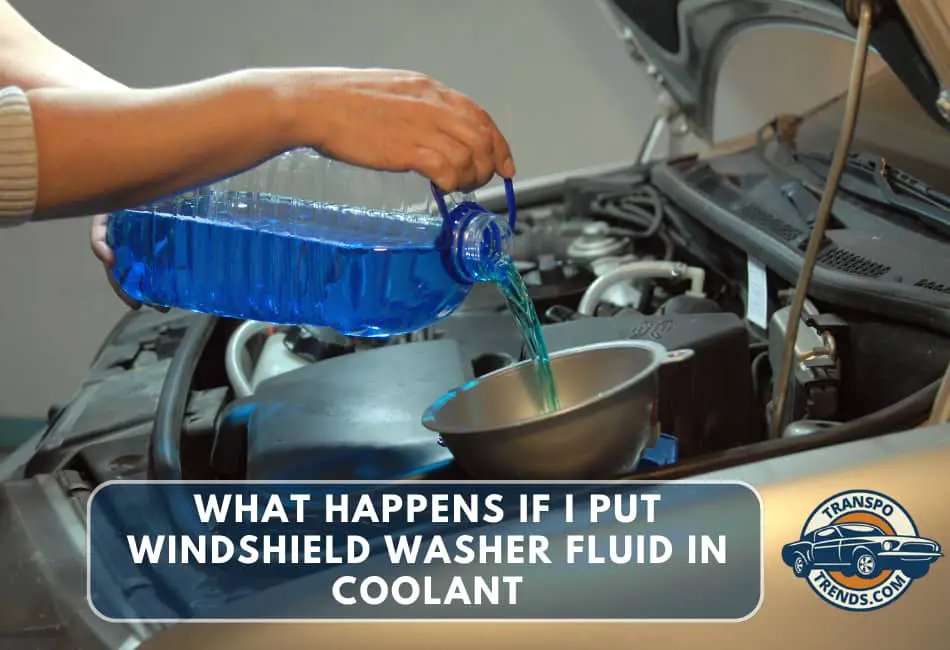Proper vehicle maintenance is crucial for extending your car’s lifespan and ensuring your safety on the road.
One area where car owners often make mistakes is managing the car’s fluids, a prime example being using windshield washer fluid instead of coolant.
While such a mistake won’t immediately wreak havoc on your vehicle’s engine, it’s far from ideal and can potentially lead to serious issues.
The aim of this blog post is to shed light on the potential consequences of this common misstep, enabling you to avoid unnecessary damage and expensive repairs.
Understanding Windshield Washer Fluid and Coolant
What is Windshield Washer Fluid?
Windshield washer fluid is a liquid solution designed specifically to clean the windshield of vehicles to improve visibility.
It often contains methanol, a type of alcohol that is very effective in dissolving dirt and bug splatter. It doesn’t freeze easily, making it suitable for various weather conditions.
The Role of Coolant in a Vehicle’s Engine
Coolant, also known as antifreeze, plays a vital role in regulating the temperature of your vehicle’s engine.
It absorbs the heat produced during combustion and circulates it away from the engine towards the radiator, where the heat dissipates.
Without the proper coolant, your engine could overheat and sustain severe damage.
The Differences Between Windshield Washer Fluid and Coolant
While both windshield washer fluid and coolant are integral to the operation of your vehicle, they serve very different functions.
The former is strictly for cleaning the windshield, while the latter is critical to the engine’s temperature regulation system.
Using windshield washer fluid instead of coolant can lead to complications, as it lacks the heat-absorbing properties of a proper antifreeze.
This can result in insufficient engine cooling, potentially leading to overheating and causing serious damage over time.
The Five Consequences
1. Reduced Engine Cooling Efficiency
- How windshield washer fluid affects the cooling system
Windshield washer fluid’s chemical composition fundamentally differs from coolant’s, and it lacks the ability to absorb and distribute heat efficiently.
When used in place of coolant, the washer fluid’s inability to manage heat effectively disrupts the engine’s cooling system.
The fluid fails to absorb the heat produced during combustion effectively, leading to an imbalance in temperature regulation.
- Potential overheating issues
This imbalance can escalate into serious overheating issues. The engine, without an effective cooling mechanism, operates at higher-than-normal temperatures.
Overheating is not just problematic, but it can also be dangerous. It may compromise the vehicle’s functionality and, in the worst case, lead to engine failure.
Continuous operation in such conditions can cause irreversible damage to the engine components, necessitating costly repairs or a complete replacement.
2. Corrosion and Damage to Cooling System Components
Windshield washer fluid is not just unsuitable for engine cooling; its chemical composition can also lead to corrosion and damage to various cooling system components.
- Chemical Composition of Windshield Washer Fluid
Windshield washer fluid typically contains methanol, a type of alcohol that is extremely effective at cleaning but can be corrosive to certain materials.
It also lacks the corrosion inhibitors found in a traditional coolant formula. These inhibitors are designed to prevent the wear and tear of the engine’s metallic parts, prolonging their lifespan and maintaining their effectiveness.
- Its Impact on Radiators, Hoses, and Other Parts
When windshield washer fluid is used in place of coolant, its methanol content can cause serious damage to the radiator, hoses, and other components of the engine’s cooling system.
These components are not designed to withstand the corrosive effects of methanol, which can lead to premature wear and tear.
This, in turn, can cause leaks, reduce the cooling system’s efficiency, and ultimately require expensive repairs or replacement parts.
Furthermore, the lack of corrosion inhibitors in the washer fluid means that even the metallic parts of the cooling system are at risk of rust and other forms of corrosion.
This could further compromise the integrity of the cooling system and the engine’s overall performance.
3. Altered Coolant Properties
- Changes in Freezing and Boiling Points
When windshield washer fluid is used as a coolant, it alters the vital physical properties of the coolant, including its freezing and boiling points.
A traditional coolant is designed to remain stable over a broad range of temperatures, from extreme cold to intense heat.
It has a lower and higher freezing point than water, preventing freezing in winter and boiling over in summer.
On the other hand, the windshield washer fluid has a higher freezing point and a lower boiling point, making it less effective at managing engine heat.
- Impact on Engine Protection in Extreme Temperatures
The changes in freezing and boiling points caused by using windshield washer fluid instead of a coolant can severely impact engine protection, especially in extreme temperatures.
The fluid could freeze in cold conditions, blocking the coolant pathway and potentially causing the engine to overheat.
Conversely, the fluid could boil over in hot climates, leading to coolant loss, inadequate cooling, and engine overheating.
These extreme temperature conditions can cause significant damage to the engine, leading to costly repairs and, potentially, a complete engine failure.
4. Potential Clogging
- Accumulation of Residue and Deposits
Another significant concern related to using windshield washer fluid as a coolant is the potential accumulation of residue and deposits within the cooling system.
Unlike dedicated coolants, washer fluids may contain surfactants and other cleaning ingredients that can leave behind residue.
Over time, this can build up and form a sludge-like deposit. These deposits can stick to the walls of the cooling system, including the radiator, water pump, and coolant lines, gradually reducing their internal diameter and ultimately leading to clogging.
- Hindrance to Coolant Flow
The deposits and residue left by the washer fluid can seriously impede the coolant flow within the system.
As these deposits accumulate, they can constrict the passages through which the coolant flows, reducing flow rates.
This can result in inefficient heat transfer away from the engine, causing it to run at higher-than-optimal temperatures.
If left unchecked, the reduced coolant flow can cause the engine to overheat, potentially leading to engine failure.
This demonstrates the importance of using appropriate coolant to ensure your vehicle’s engine’s longevity and optimal performance.
5. Increased Maintenance Costs
Misusing windshield washer fluid as a coolant can lead to elevated maintenance costs in several respects.
- Repairing or Replacing Damaged Components
Using improper substances in the cooling system can damage the engine and associated components seriously.
For instance, the overheating caused by inadequate cooling can degrade and warp engine parts, necessitating costly repairs.
The residue and sludge caused by washer fluids can also impair the functioning of components like the water pump and radiator.
These affected parts may require extensive repairs or full replacement, leading to substantial expenses.
- Flushing and Replacing the Contaminated Coolant
When the cooling system is contaminated with residues from the washer fluid, it’s not enough to add the correct coolant into the mix.
The system must be thoroughly flushed to remove the damaging deposits and sludge. This process can be time-consuming and costly, particularly if it has to be done frequently due to ongoing misuse of washer fluid as coolant.
After flushing, the system must be refilled with the appropriate coolant, adding a further expense.
Overall, the increased maintenance costs associated with improper coolant use make the correct choice of coolant not just a matter of vehicle performance but also financial prudence.
Signs to Watch For
Identifying early signs of potential coolant contamination is essential to prevent significant damage to your vehicle’s engine.
Here are some ways to determine if windshield-washer fluid has mistakenly been used and common symptoms of coolant contamination:
How to Identify if Windshield Washer Fluid Has Been Mistakenly Used
- Identifying the use of windshield washer fluid in place of coolant can be challenging, as both fluids are typically brightly colored.
- However, when heated, the washer fluid tends to be thinner, producing a strong alcohol-like smell.
- Upon visual inspection, if the fluid in the coolant reservoir appears thinner than usual and has a strong odor, it may indicate the misuse of washer fluid.
- Consulting with a professional mechanic for a thorough inspection is strongly advised.
Common Symptoms and Warning Signs of Coolant Contamination
Contaminated coolant can lead to several warning signs. One common symptom is overheating your vehicle’s engine, causing it to run less efficiently and possibly resulting in frequent breakdowns.
Also, you may notice a significant decrease in the performance of your heating and cooling system, as the contaminated coolant struggles to regulate the vehicle’s temperature effectively.
Visible residue or sludge in the coolant reservoir is another clear sign of contamination. This sludge can lead to blockages and wear out the engine’s components prematurely.
If you observe these symptoms, seeking professional help immediately is crucial to prevent further damage and costly repairs.
Preventing and Resolving the Issue
Reading Labels and Using the Right Products
One of the most proactive steps in preventing coolant contamination is ensuring using the correct fluids for your vehicle.
It’s vitally important to always read labels before adding any substance to your car. Products designed for specific uses often have distinct chemical compositions that can cause significant damage if misused.
Using the correct fluids not only sustains your vehicle’s longevity but also ensures your drive’s safety and efficiency.
Steps to take if you suspect windshield washer fluid was used
- Flushing the Cooling System
If you suspect that windshield washer fluid has been used instead of coolant, the first step is to flush the entire cooling system.
This process involves draining the contaminated coolant, then running water or a specially designed coolant flush product through the system to clean out residual contamination.
Once thoroughly flushed, the system should be refilled with the correct coolant, as the vehicle’s manufacturer recommends.
- Inspecting and Repairing any Damage
Once the cooling system is flushed and refilled, a thorough system inspection should be performed to identify any damage that may have resulted from the misuse of windshield washer fluid.
This includes checking hoses, seals, and other components for signs of erosion or other damage.
Any compromised parts should be repaired or replaced to avoid further issues. In some severe cases, professional mechanical intervention may be required.
Conclusion
In sum, using windshield washer fluid instead of coolant can cause serious damage to your vehicle, potentially leading to costly repairs and harmful effects on overall vehicle performance.
Proper vehicle maintenance is not merely a suggestion but an essential practice for any vehicle owner. Ensuring the use of the correct fluids is one of the most primary yet significant steps towards this.
We strongly encourage you to share this information with other vehicle owners. Spreading awareness about this common misconception could save someone from a costly mistake and help foster a culture of diligent and informed vehicle maintenance.

